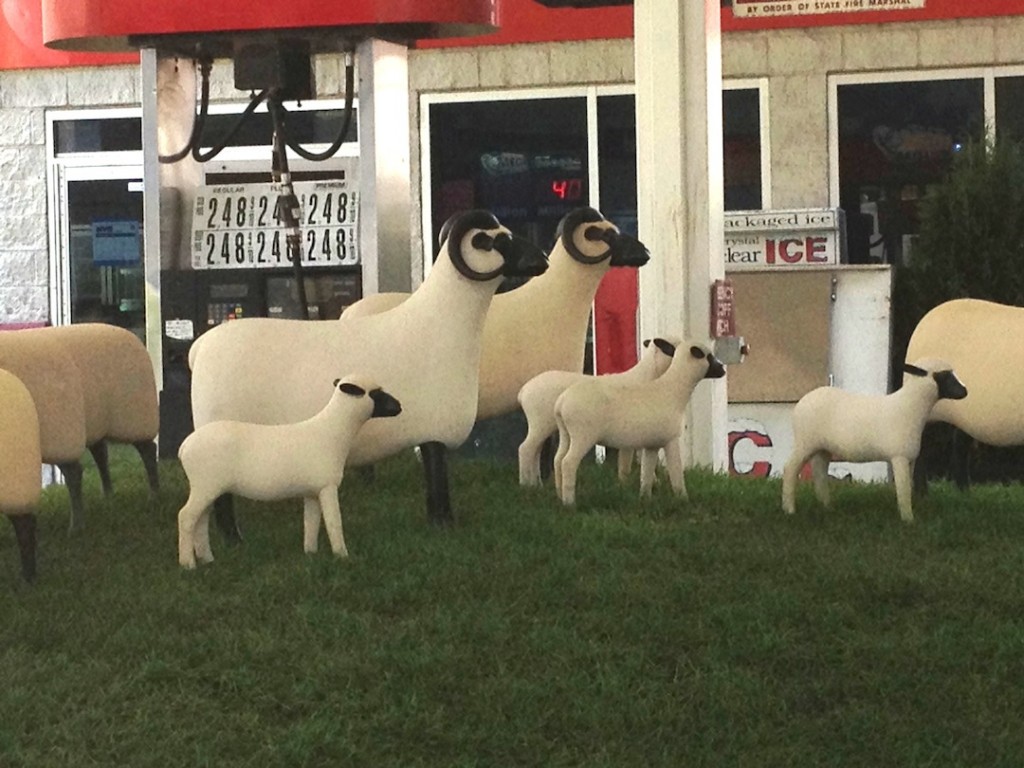Four legs good, two legs better
As I headed down 10th Ave. a couple weeks ago, I saw, for the first time, the at-first-glance bucolic installation of sculptured sheep by Fancois-Xavier Lalanne, where once I would have seen lines of cabs stretched into the avenue, waiting for gas. Paul Kasmin and real estate developer Michael Shvo have turned what was a Lukoil gas station into Getty Station, an outdoor gallery, complete with white fence, fake rolling pasture, and a soothing herd of sheep. It isn’t the first time the station has been used to exhibit art, but in the past, the gas kept flowing. The name is a nice turn: suggesting both the petroleum and the art associated with the Getty brand. Also nice: gas prices on the vertical sign have been replaced with the show’s opening and closing dates. A dignified gallery minion guarded the art and handed out leaflets about the show. The gas station’s metamorphosis has gotten a lot of publicity—it’s friendly, funny, a natural target for cell phone photographers. It’s nicer to walk past this site now than it was a month ago when overheated cabs clogged the sidewalk and street. They exhaled a bomb of exhaust that cloaked the entire corner. But they were there because we needed them, and they needed that gas station. It was a handy stop for people in the neighborhood who wanted a lift and income-sustaining for the drivers. (Kasmin told the Wall Street Journal that many have asked him, “Where can I catch a cab now?” Gosh, I don’t know. By walking a couple blocks and looking for the glowing number on the roof, maybe . . . )
My reaction to the change was mixed. Two weeks ago, as I walked through once-familiar areas of West Chelsea, I saw one example after another of a real estate boom. Across from the building that houses Viridian Artists and many other galleries, and which serves as home base for me, a large complex of “affordable housing” has been going up for months. Now, on the corner of 10th and 28th, where we used to buy sandwiches, Diet Cokes and an occasional beer, our friendly bodega was gone, and the site was locked down with steel shutters. I was told residences are going to be built there as well, and developers have pushed the little shop a block north to 29th. All of this would be encouraging, if I hadn’t lived through 2008 and witnessed the fallout of the real estate debacle ever since. When I stood at the edge of the pretend picket fence at Getty Station, all I could think about was the Wal-Mart syndrome—big money coming into an area and snuffing little enterprises on Main Street. Only in this case it’s big art money shutting down what appeared to be a small, thriving franchise serving a vital need for cab drivers hustling to make a living. The sheep are pleasant, but no one needs them. That gas station was alive, and small businesses exhibiting that station’s healthy vital signs are all that will turn the current economy around. Walking through so many galleries in Chelsea, as I do whenever I come to town, it already feels like walking through a string of high-end car dealerships, where the price tags are so out of reach for nearly anyone but the ultra-rich, you feel as if you’re peering through someone’s window into a lavish dinner party. Every time I walked past the old gas station, it was nice to see a little hint of how most people scrape together enough to pay the bills and keep a car running. It was a quick little sniff of reality on my way between the clean, filtered air of one white cube and the next. Those industrious cab drivers getting their tanks filled at the old Lukoil station were the sort of mudders who keep the American horse race alive. This installation of artificial sheep was cute, family-friendly, amusing and cheerful, but it depressed the hell out of me. I looked at the gallery attendant and shook my head, with a half-smile, and said, “Chelsea.” He nodded and smiled right back in exactly the same way, and said “Yup”, and then handed someone else one of his leaflets. I could have just said, “America.”

Comments are currently closed.